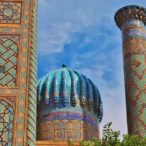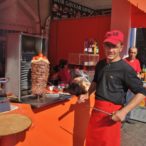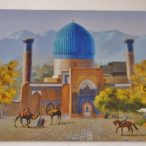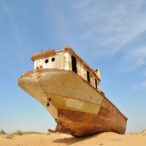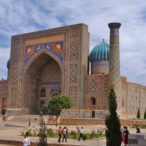Uzbekistan
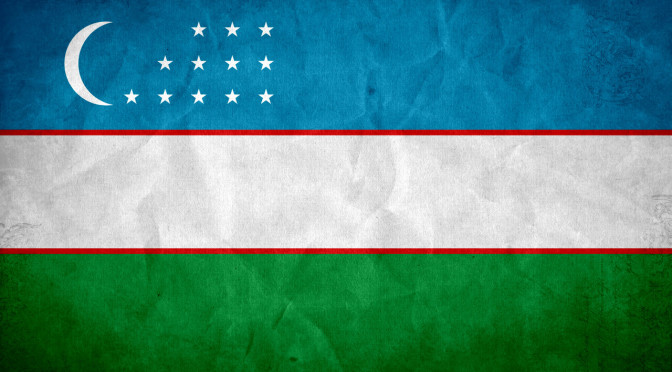
Official name: Republic of Uzbekistan
Population: 30 683 000
Area: 448 978 km²
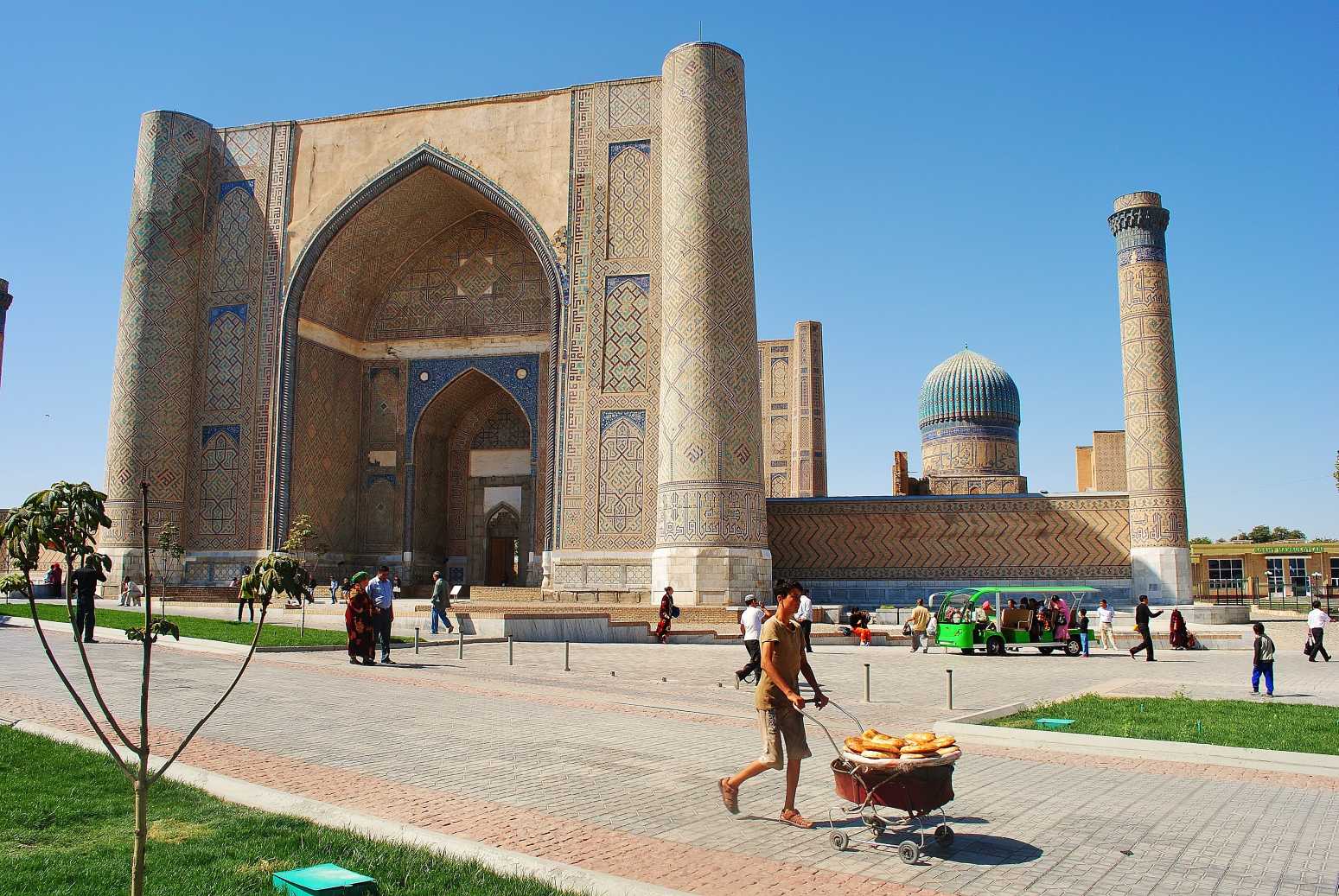
Gallery
Tourist attractions of Uzbekistan, Uzbekistan – the present times, brief history of Uzbekistan.
Tourist attractions of Uzbekistan
Uzbekistan is a pearl of the Silk Road as evidenced by splendour of the three most magnificent ancient cities. These are of course: Samarkand, Bukhara and Khiva. We can admire all the wonderfully restored buildings mostly from the times of Timur, who was one of the greatest rulers of the territory which today we know as Uzbekistan. Numerous mausolea, minarets and madrassas, which are richly decorated from outside and inside give a breathtaking effect. Presence in each of the ancient cities also gives a great haggling opportunity over a beautiful carpet, silk, ceramics, paintings, hand-crafted caskets and many other interesting souvenirs. I spent many days on careful exploration of the old cities, on sightseeing, having green tea and eating samsa which are the local dumplings.
Exchanging dollars into worthless Uzbek som was also a great experience because for one $100 note I had half of a bag of local currency. However Uzbekistan is not only about the historic old cities, but also about adventure whilst crossing Kyzyl-Kum desert on the way to Khiva. I also recommend the village of Moynaq in the far away Karakalpakstan where we can see the rusty fishing boats on sand, and learn about the Aral Sea ecological disaster. Uzbek Fergana Valley is also a nice experience, where we can enjoy lower mountains of Central Asia, lakes, herds of sheep grazing on their pastures and then also shashlyks made of sheep (skewers). Very Interesting and worth our time is also the capital of Uzbekistan – Tashkent, as well as trip out of town to Chimgan.
Besides, people in Uzbekistan have good attitude towards tourists and low prices make our travelling more enjoyable. From time to time it is also good to take a break from sightseeing and enjoy a mutton shashlyk or plov, the culinary pride of Uzbekistan. The only thing that I didn’t like about Uzbekistan was the insane bureaucracy towards tourists, and that one thing should be definitely changed. On the other hand Uzbeks hate their bureaucracy even more than tourists.
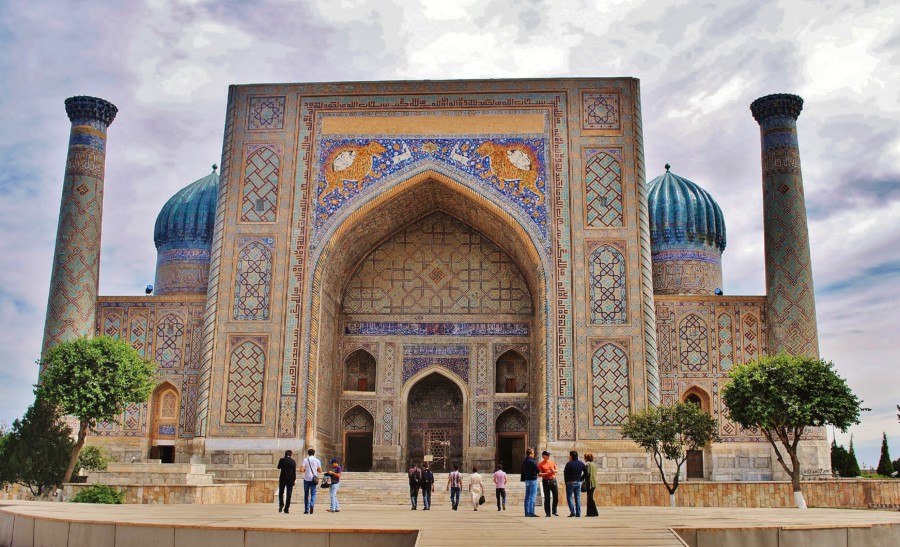
Registan – Samarkand.
Uzbekistan – the present times
Economy:
By Western media Uzbekistan is often described as “an authoritarian police state” where the eternal president Karimov controls his country by bureaucracy which even he most probably does not fully understand. Uzbekistan has rather low economic freedom and lack of civil liberties, but instead it is drowning in bureaucracy and corruption. Immediately after gaining independence inflation was standing at 100%, but soon fell to 50% and is now at around 10% (just for a comparison, inflation in Poland is at a very high level of 4.2%, and in the UK at about 2%). Salaries are about $100 a month but recently, because in 2007 it was about $30. President Karimov, however, claims that it is more than $200 in which hardly anyone believes. Generally, whilst travelling around Uzbekistan I realized that life is hard there and people don`t earn a lot of money. I don`t think that even approximate data relate to real earnings of people living in small villages scattered on the other end of the Kyzyl-Kum desert. The largest banknote of 1000som is only worth about £0.45, what means that a whole bag of money is worth only about £30.
Onother big problem is unemployment, undercut wages and emigration of Uzbeks to Kazakhstan and Russia. It is estimated that about 25% of Uzbekistan’s labour force lives outside the country, what means that the are about 4 million Uzbeks working illegally mostly in Russia and Kazakhstan. It is however a very unreliable data, because about 5 million Uzbeks of working age live permanently in Kazakhstan. The official unemployment rate is only 1% but as much as 20% is underemployed, and the statistic data helps the fact that its citizens work abroad. (By the way, the Polish government also boasted that the unemployment rate fell, but it did not mention that only because millions of Poles work in neighboring countries). In my opinion the biggest problem that limits the Uzbek economy is stubbornness and stupidity of president Karimov. Karimov temporarily closes the borders with neighboring countries what also stops the flow of goods and services. In addition to the regime which Karimov has brought into all spheres of public life, in Uzbekistan there is also a regime which limits foreign investments and controls agricultural crops. One of the most important crops in Uzbekistan is cotton on which Karimov has a tight grip, even at the cost of further contamination of the Aral Sea.
The banking system is filled with bureaucracy, and the black market although is an adventure for visitors, to the Uzbek government is a great loss. The best example is the currency exchange at a government price and the free market price. In currency exchange offices the local currency can be bought for 40% more expensive than outside a public toilet or in a cafe. Uzbekistan is also very rich in natural resources, including gas and oil, which is used for their own consumption. It is also a big exporter of gold and silver but makes airplanes and tractors too. On the other hand Uzbekistan also produces silk, cotton, vegetables and fruit. Agriculture accounts for about 25% of Uzbekistan`s GDP, and although cotton is of great importance it is grown less than before in favour of cereals. Karimov`s regime sents children, students and hospital workers to the cotton fields, what one newspaper described as “wealth reached by the hands starving children.” Prices for cereals are unfair what caused increase in keeping cattle. Many people rely on selling their own farmed eggs, meat and milk.

Samarkand. Uzbekistan.
In addition, according to the official data the Uzbek nation loves their president very much, because 99% attended the election and 99% voted unanimously for Karimov. Astonishing, isn’t it?! From what I can remember they voted in exactly the same way for Stalin.
Education:
Education in Uzbekistan is free and compulsory for 11 years of primary and secondary schools. Official literacy level stands at a high 99% and attendance to schools is good. The educational system was better in the times of the Soviet Union, and today Uzbekistan gives only about 8% of their national income for education and most of it is for universities. Unfortunately, to get to the university or to climb up the career ladder bribery is necessary.
Health:
Free health care in Uzbekistan is guaranteed by the constitution, but only in writing. After the collapse of the Soviet Union healthcare funding also collapsed, which currently stands at 11% of GDP. A lot of medical workers work in Russia because of low wages in Uzbekistan. Hospitals are often bare walls because they lack basic things as: needles, syringes, bandages and antibiotics. Number of hospital beds per 10,000 people is only 53 (for comparison, in Bangladesh it is only 4 per 10,000).
Often to get to the hospital people have to give bribes. Most of diseases come from dirty water: cholera, hepatitis, dysentery, typhoid, and various types of cancer. As for maternity care Karimov`s regime is hiding a lot of things, but generally childbirth carries big risks for women and their children. Maternal mortality during childbirth s about 30 per 10,000 and child mortality under 5 is 38 per 1000, and the numbers have slightly improved. The worst health situation appears to be in the Aral Sea area.
When it comes to HIV the numbers have increased mainly due to drug use and drug smuggling from neighbouring Afghanistan. It is possible that there are currently about 30,000 people living with HIV in Uzbekistan.

Uzbek beauty.
Culture/Religion:
In Uzbekistan there are mainly Uzbeks (71%), Russians (8%), and people from other countries of Central Asia (Tajikistan, Kazakhstan). One of the minorities are also Armenians. The population of Uzbekistan is the largest of all the countries of Central Asia as it is over 28mln and the leading religion is Islam (85%). However, as it is in case of other countries of Central Asia, in Uzbekistan Islam has cultural background and it is not in any way similar to Islam which we know from Pakistan and Saudi Arabia. Many Uzbeks are Muslims but do not even know how to practice Islam. Alhough Islam is important in the lives of Uzbeks and many rituals, festivals and marriage ceremonies are based on Islam, Karimov is afraid of fundamentalism. Uzbeks are of Mongolian and Turkish origin, and although they are all Uzbeks, many of them speak several languages ??and believe to be culturally closer with neighboring nations.
People of Karakalpakstan were once a separate republic and now they are an autonomous region, they have different language and customs, and they identify themselves more with Kazakhstan than Uzbekistan. There are also those who have chosen to live in yurts near the border with Kyrgyzstan, and therefore they identify themselves with that country. The cities of the Silk Road once belonged to Tajikistan and today there are more Tajiks in Samarkand than Uzbeks. 14% of the population speaks Russian as their first language and 5% speaks Tajik. The government promotes Uzbek language and Uzbek culture, but Russian is known almost by everyone. There is also a bazaar culture in Uzbekistan, where in addition to stalls of carpets and other goods whole families meet to talk and have a cup of tea, having a rest on chaikhanas in tea houses.
Women usually get married up to 21 and marriages are arranged, although in larger cities young couple choose for themselves. However even then the parents have the final say. Polygamy is illegal but it happens anyway and divorces are rare. Taking care of the household and the children are responsibilities of women, and in the case of divorce children are also taken by women. There is also a greetings etiquette based on a handshake with left hand put on the heart, and the elderly are particularly respected. Women are expected to by shy towards men and when a man talks to a woman it is customary to ask about the health of her husband. As it is in the case of Kyrgyzstan, in Uzbekistan the youngest son has to take care of his parents, that`s why he inherits their house and especially his wife is chosen by the parents.
Uzbek cuisine is similar to others in the region. The main dishes are plov which is the national pride of Uzbekistan, skewers made of goat and sheep (shashlyk) to drink green tea, and for dessert fruit, nuts, almonds and halva. Even though it is an Islamic country, drinking wine is very popular and Uzbekistan has 14 wineries. Another popular custom is baking bread in ovens outside houses and in the streets, and baking mutton dumplings called samsa. In Bukhara they cost only 1000 som what means that they are practically free of charge.
Women traditionally wear long dresses and shawls on their heads, and men wear square hats and rich in patterns long coats. Literature and art of Uzbekistan have Persian and Turkish roots. Alisher Navoi is the national poet and monuments of him can be seen in many parts of Uzbekistan.
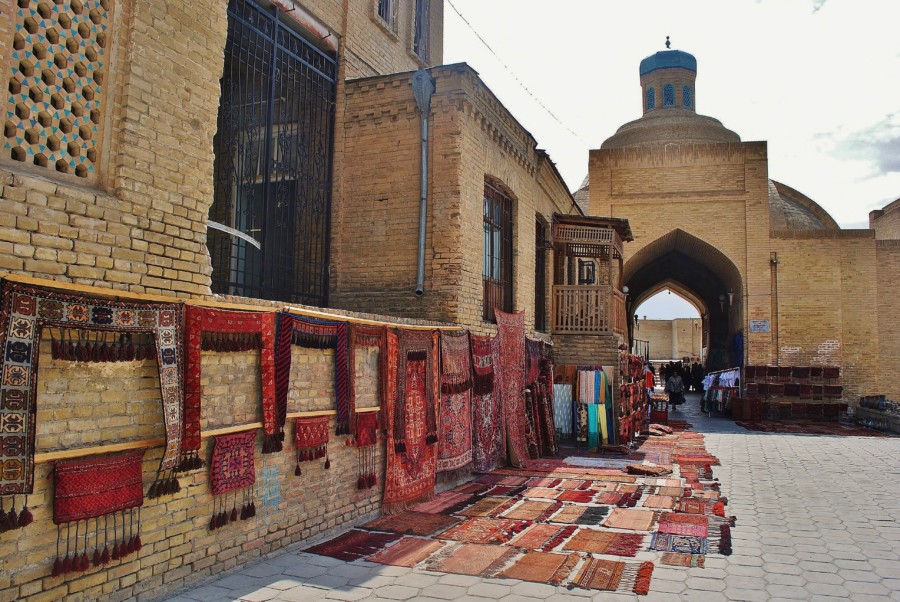
Bukhara. Uzbekistan.
When it comes to sport Uzbekistan has many achievements, both in their national colours, as well as earlier in the colours of the Soviet Union. In general, all popular sports are very much alive in Uzbekistan, although the greatest achievements the country has in cycling and boxing.
Media:
Freedom of the press and publication in Uzbekistan does not exist. President Karimov who has been in power for over 20 years does not allow any opposition and news from outside. Foreign websites and TV and radio stations are blocked and Uzbek people have access only to those news which are seen as “appropriate and harmless,” according to president Karimov. In the background of global conflicts and taking into account reserves of gas, oil and cotton Uzbekistan is a “black hole” of the world where hardly anyone looks and a lot of people do not even know about the existence of this country. It appears that Karimov is in a very good position and he can develop freedom in his own unique way. On the press freedom index Uzbekistan is on 157th place, almost at the very end of the list.
Environmental problems:
Environmental issues in Uzbekistan are a true horror story, and the greatest tragedy and shame is the Aral Sea Ecological Disaster, which I wrote an extensive and detailed article about. This problem is very important and I urge you to read my article.
Besides, other problems are contamination of agricultural soil, drinking water and rivers, what causes a lot of diseases (see “Health” chapter above), and the excessive use of pesticides and various chemicals in agriculture. There is also a large air pollution in Uzbekistan because of strong industrialization, but these problems are ignored for political and economic reasons. Uzbekistan has a conservation program that is effectively stopped by the bureaucracy and desire to profit.
History of Uzbekistan
Uzbekistan lies in the middle of Central Asia, between the rivers of Amu Darya and Syr Darya. It has long and interesting history connected with the history of the Silk Road. The ancient cities such as Samarkand, Bukhara and Khiva which are in Uzbekistan, througout the centuries many rulers conquered these areas and developed trade and splendour of this region. In 327 BC Alexander the Great passed through Uzbekistan on the way to India. In the VIII century Uzbekistan was conquered by the Arabs who introduced Islam. Then in the IX century the whole area was ruled by the Shaybanid Empire but only up to 1220 when Genghis Khan took control over entire Central Asia. When the Mongol Empire began to crumble Timur created his own empire with the capital in Samarkand. Most tourist attractions which we can admire today come from that time. After the death of Timur his empire was divided into many clans with strong Muslim ties with Persia.
Russia’s trade with Central Asia grew considerably in the XVI and XVII centuries, and in 1865 Russia occupied Tashkent. It only increased the strength of Russia which in the late XIX century occupied entire Central Asia. At that time because of Afghanistan the Russian and the British Empires avoided war and their borders were established on the basis of an agreement between the two. In 1876 Russians finished the Khanate of Kokand and the khanates of Samarkand and Bukhara were under direct Russian protectorate. The whole of Central Asia at that time was under colonial authority of Russia, which invested in infrastructure and industry in the region. Russia developed cotton cultivation and introduced settlement of ethnic Russians in the territories of Central Asia.
In 1924 out of the territories of Samarkand, Bukhara, Khiva and Fergana Valley Russia created The Soviet Socialist Republic of Uzbekistan. Another important element of Russian policy in that period was that Russia was using Uzbekistan for growing cotton and its natural resources. However the primitive irrigation system led to the Aral Sea environmental disaster, which volume has by now decreased by about 90%. The Aral Sea disaster is considered to be the largest natural disaster of Central Asia and the whole world.
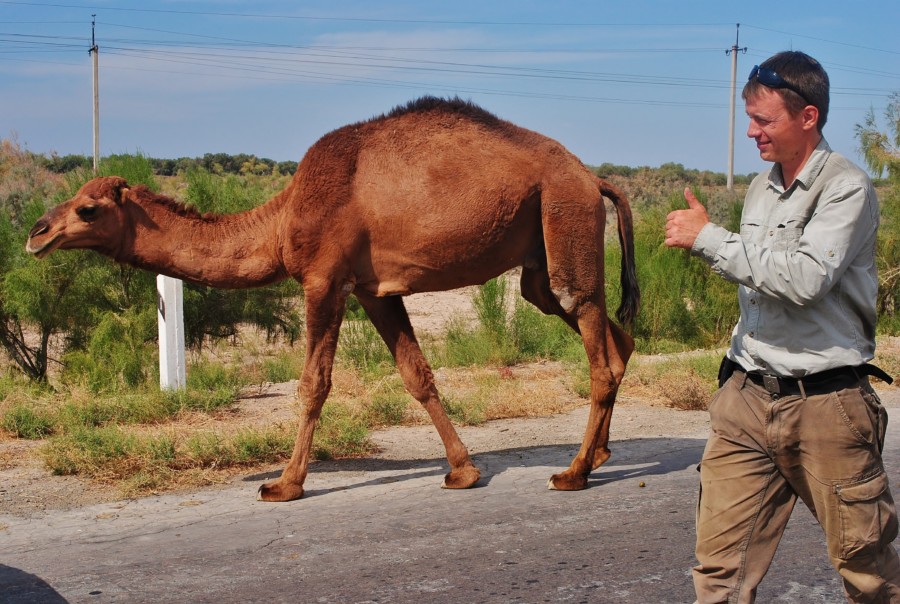
A traveller from Poland met wild camels on his way. Uzbekistan.
The breakthrough came with the collapse of the Soviet Union in 1991, what meant that Uzbekistan became independent. Islam Karimov became president because he won 88% support, and in the Soviet times he was the first secretary of the Communist Party. As it is with all the other post-Soviet republics, also in Uzbekistan elections are rigged, and Karimov became the eternal president and kept power until his death in 2016.
Travel reports
Map
Location
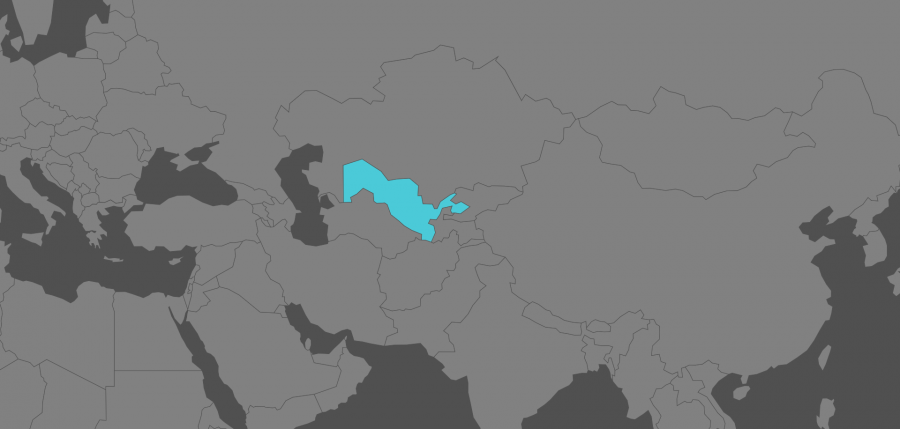
Practical information
Tourist visa: Uzbekistan was a bureaucratic nightmare for tourists who wanted to visit this country. The bureaucracy was so terrible that I’ve had enough of travelling around Uzbekistan well before arrival. Fortunately, on the 1st of February 2019 Uzbekistan abolished visas for Poles, British and most Europeans, provided that the stay would not exceed 30 days.
Although this information is no longer valid, I would like to write about the Uzbek bureaucracy and registration in OVIR, when I was there in 2010: travel to Uzbekistan begins at the moment of applying for a visa well what I discovered. The bureaucracy of this country can spoil the desire to visit, but my advice is do not give up. First I had to try the “official invitation” from the local base in Uzbekistan. For this purpose, I sent an email to the office of the traveler, who sent me an invitation after the two weeks before I sent to their account € 29 So I filled visa application form, I added the photo and went to the consulate in London. Since then the procedure was very easy but also expensive. For single entry visa monthly paid £ 57 but you can get for less and then it will be slightly cheaper. Since the submission of papers at the consulate visa was ready after three days. Any official hotel in Uzbekistan is obliged to register guests, issue receipts and send that information to police immigration (OVIR).
Security: I’m not sure what other sources but I think Uzbekistan is very safe. Not only in major cities but also in smaller towns and villages in the far away Karakalpakstan.
Getting around the country: in comparison with other countries in the region move through Uzbekistan is very easy. Within the Samarkand-Tashkent-Bukhara and Samarkand are cheap buses and shared taxis expensive. There is also a night train from Samarkand to Urgench where shared taxi or trolley bus slowest of the world can get to Khivy 30km. In the area of ??shared taxis Karakalpakstan recommend unless you have a lot of time and we want to squeeze like sardines.
Prices (2010): for the hotel I paid an average of about $ 10 but I happened to pay even $ 6 It should be assumed that the $ 10 per night is a good price and hostels especially in Samarkand and Bukhara offer excellent conditions and are located near the old city. The food is very cheap. With a bus from Samarkand to Bukhara I paid about $ 7 a bus from Bukhara to Khiva $ 20 It remains to enter the buildings. I think that by calculating the mean and not giving a stretch, about $ 20 – $ 25 per day should be enough. The haggling help Russian language skills.
Climate: continental with hot summers and cold winters. In summer the air temperature can reach up to 40oC and in winter even fall -40oC. A large part of the country is too dry, especially in the Kyzyl Kum desert and the tragedy of the Aral Sea. Precipitation is small.



